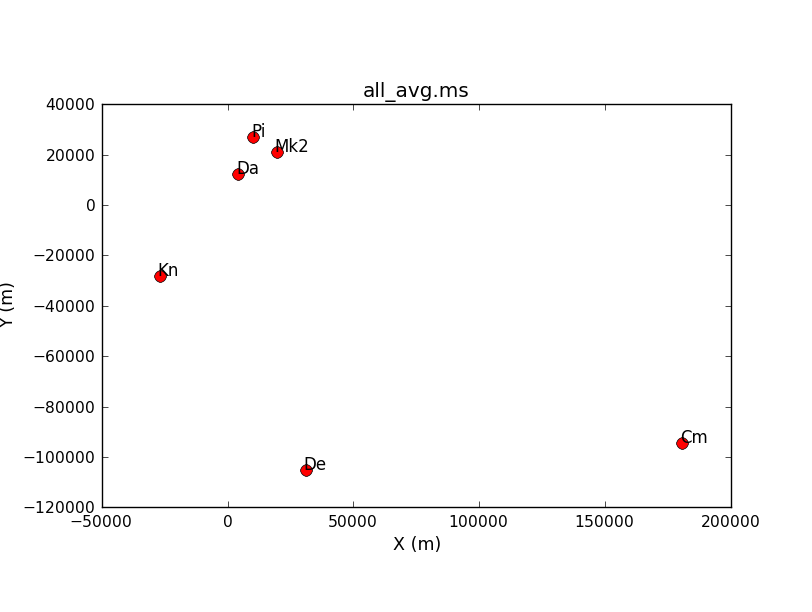
This guide provides a basic example for calibrating e-MERLIN C-Band (5 GHz) continuum data in CASA. It has been tested in CASA 4.3-5.3. It is designed to run using an averaged data set all_avg.ms (1.7 G), in which case you will need at least 5.5 G disk space to complete this tutorial.
If you have a very slow laptop, you are advised to skip some of the plotms steps (see the plots linked to this page instead) and especially, do not use the plotms options to write out a png. This is not used in this web page, but if you run the script as provided, you are advised to comment out the calls to plotms or at least the part which writes a png, see tutors for guidance.
3C277.1 is a twin-lobed radio galaxy. These C-band (4-7.3 GHz) e-MERLIN observations were made specifically for this tutorial but previous MERLIN and VLA images have been published by Ludke et al. 1998 and Cotton et al. 2006 . The e-MERLIN User Support web page describes e-MERLIN data in more detail, including the Cookbook and the AIPS pipeline
The CASA home pages describe downloading and installing CASA; also see Getting Started in CASA .
Data all_avg.ms.tar ( wget -c http://almanas.jb.man.ac.uk/amsr/3C277p1/all_avg.ms.tar ) 1.6 GB
Script equivalent of this guide, to be filled: 3C277.1_cal_outline.py
Amplitude calibrator model ( wget -c http://almanas.jb.man.ac.uk/amsr/3C277p1/3C286_C.clean.model.tt0.tar )
tar xvf all_avg.ms.tar tar xvf 3C286_C.clean.model.tt0.tarYou should be working in the directory containing the data all_avg.ms, the script 3C277.1_cal_outline.py, and 3C286_C.clean.model.tt0
This User Guide presents inputs for CASA tasks e.g. gaincal to be entered interactively at a terminal prompt for the calibration of the averaged data and initial target imaging. This is useful to examine your options and see how to check for syntax errors. You can run the task directly by typing gaincal at the prompt; if you want to change parameters and run again, if the task has written a calibration table, delete it (make sure you get the right one) before re-running. You can review these by typing:
# In CASA: !more gaincal.last
taskname = "gaincal" vis = "all_avg.ms" caltable = "bpcals_precal.ap1" ... ... #gaincal(vis="all_avg.ms",caltable="bpcals_precal.ap1",field="1407+284",spw="",intent="", selectdata=True,timerange="",uvrange="",antenna="",scan="",observation="",msselect="",solint="120s", combine="",preavg=-1.0,refant="Mk2",minblperant=2,minsnr=2,solnorm=True,gaintype="G",smodel=[], calmode="ap",append=True,splinetime=3600.0,npointaver=3,phasewrap=180.0,docallib=False,callib="", gaintable=['all_avg.K', 'bpcals_precal.p1'],gainfield=[''],interp=[],spwmap=[],parang=False)
When you are happy with the values which you have set for each parameter, enter them in the script 3C277.1_cal_outline.py (or whatever you have called it). You can leave out parameters for which you have not set values; the defaults will work for these (see e.g. help(gaincal) for what these are), but feel free to experiment if time allows.
The script already contains most plotting inputs in order to save time. Make and inspect the plots; change the inputs if you want, zoom in etc. There are links to copies of the plots (or parts of plots) but only click on them once you have tried yourself or if you are stuck.
The parameters which should be set explicitly or which need explanation are given below, with ** if they need values.
If you have already plotted the antenna positions with plotants you will have seen that Mk2 has many short baselines which makes it more likely to give good calibration solutions and it makes a good reference antenna (refant).
The imput data set all_avg.ms contains five fields:
| e-MERLIN name | Common name | Role |
|---|---|---|
| 1252+5634 | 3C277.1 | target |
| 1302+5748 | J1302+5748 | phase reference source |
| 1407+284 | OQ208 | bandpass cal. (usually about 2 Jy at 5-6 GHz) |
| 0319+415 | 3C84 | bandpass, polarization leakage cal. (usually 10-20 Jy at 5-6 GHz) |
| 1331+305 | 3C286 | flux, polarization angle cal. (flux density known accurately, see Step 7) |
These data were taken in full polarization in 0.512 GHz bandwidth centred on 5072 MHz, in 4 adjacent spectral windows (spw's, also known as IFs). Each 128-MHz spw contains 512 channels 0.25 MHz wide and 1 s integrations were used (the data are later averaged).
The preprocessing of the original raw fits idi files involved (see the full script e-MERLIN-CASA_v0.1.py steps 1-3 for details):
Check that you have all_avg.ms in a directory with enough space and start CASA.
Enter the parameter to specify the MS and, optionally, the parameter to write the listing to a text file.
# in CASA listobs(***)
Because e-MERLIN stores data for each source in a separate fitsidi file, the sources are listed one by one even though the phase-ref and target scans interleave. So selected entries from listobs, re-ordered by time, show:
Timerange (UTC) Scan FldId FieldName nRows SpwIds Average Interval(s) #(i.e. RR RL LR LL integration time) 05-May-2015 ... 20:02:08.0 - 20:05:08.5 7 0 1302+5748 2760 [0,1,2,3] [3.91, 3.91, 3.91, 3.91] # phase-ref 20:05:11.0 - 20:12:33.5 72 1 1252+5634 6660 [0,1,2,3] [3.98, 3.98, 3.98, 3.98] # target 20:12:36.0 - 20:15:34.5 8 0 1302+5748 2700 [0,1,2,3] [3.96, 3.96, 3.96, 3.96] # phase-ref ... 22:02:04.0 - 22:47:00.5 132 2 1331+305 40500 [0, 1, 2, 3] [3.99, 3.99, 3.99, 3.99] # flux scale/pol angle calibrator 22:47:03.0 - 23:29:59.5 133 3 1407+284 38700 [0, 1, 2, 3] [3.99, 3.99, 3.99, 3.99] # bandpass calibrator 06-May-2015 07:30:03.0 - 08:29:59.5 134 4 0319+415 54000 [0, 1, 2, 3] [4, 4, 4, 4] # bandpass/leakage calibrator
There are 4 spw
SpwID Name #Chans Frame Ch0(MHz) ChanWid(kHz) TotBW(kHz) CtrFreq(MHz) Corrs 0 none 64 TOPO 4817.000 2000.000 128000.0 4880.0000 RR RL LR LL 1 none 64 TOPO 4945.000 2000.000 128000.0 5008.0000 RR RL LR LL 2 none 64 TOPO 5073.000 2000.000 128000.0 5136.0000 RR RL LR LL 3 none 64 TOPO 5201.000 2000.000 128000.0 5264.0000 RR RL LR LL
and 6 antennas
ID Name Station Diam. Long. Lat. ITRF Geocentric coordinates (m) 0 Mk2 e-MERLIN:02 24.0 m -002.18.08.9 +53.02.58.7 3822473.365000 -153692.318000 5085851.303000 1 Kn e-MERLIN:05 25.0 m -002.59.44.9 +52.36.18.4 3859711.503000 -201995.077000 5056134.251000 2 De e-MERLIN:06 25.0 m -002.08.35.0 +51.54.50.9 3923069.171000 -146804.368000 5009320.528000 3 Pi e-MERLIN:07 25.0 m -002.26.38.3 +53.06.16.2 3817176.561000 -162921.179000 5089462.057000 4 Da e-MERLIN:08 25.0 m -002.32.03.3 +52.58.18.5 3828714.513000 -169458.995000 5080647.749000 5 Cm e-MERLIN:09 32.0 m +000.02.19.5 +51.58.50.2 3919982.752000 2651.982000 5013849.826000
Click here to see the output you would have got for the listing of all_avg.ms: all_avg.listobs.txt
Enter one parameter to plot the antenna positions (optionally, a second to write this to a png).
# in CASA plotants(***)

Consider what would make a good reference antenna. Although Cambridge has the largest diameter, it has no short baselines.
Plot the uv coverage of the data for the phase-reference source. See annotated listobs output above to identify this. You need to enter several parameters; some have been done for you:
# in CASA
plotuv(vis='***',
field='***', # phase-ref
maxnpts=10000000, # to plot all the data
symbol='.', # a dot which will have a different colour for each spw
figfile='') # fill this in if you want a png
The u and v coordinates represent (wavelength/projected baseline) as the Earth rotates whilst the source is observed. Thus, as each spw is at a different wavelength, it samples a different part of the uv plane, improving the aperture coverage of the source, allowing Multi-Frequency Synthesis (MFS) of continuum sources.
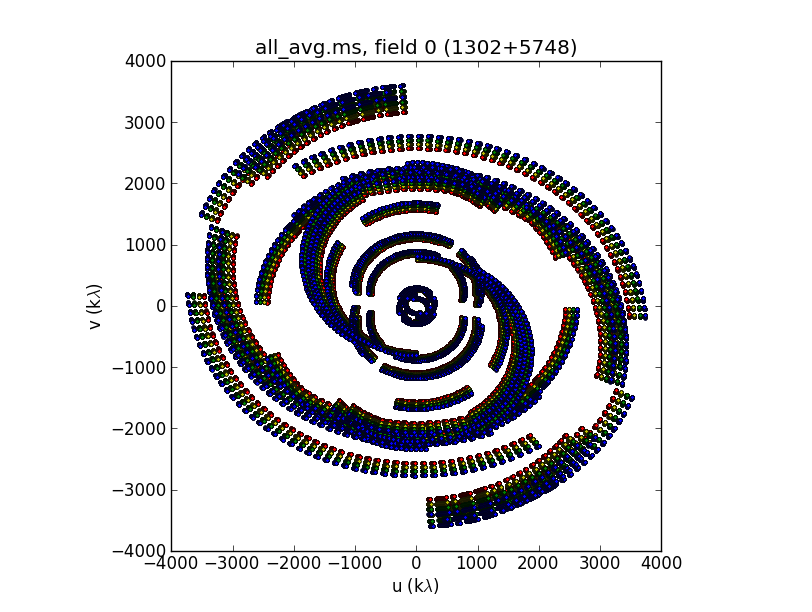
Use plotms to plot the phase-reference source amplitudes as a function of time. Just a few central channels are selected and averaged; enough to give good S/N but not so many that phase errors across the band cause decorrelation (in real life, you might have to experiment with different selections or plot phase v. channel to make the selection).
# in CASA
plotms(vis='***',
field='***', # phase-ref
spw='0~3:20~43', # plot just the inner 3/8 of the channels for each spw (see listobs output)
avgchannel='***', # average these channels
xaxis='**',
yaxis='**',
antenna='Mk2&*', # This uses Mk2 as refant for ease of comparision but another with many short baselines could be used.
correlation='**,**', # Just select the parallel hands, since the cross hands (polarised intensity) are much fainter.
coloraxis='***') # Color by baseline or correlation as you prefer
You can change the parameters interactively once plotms has started.
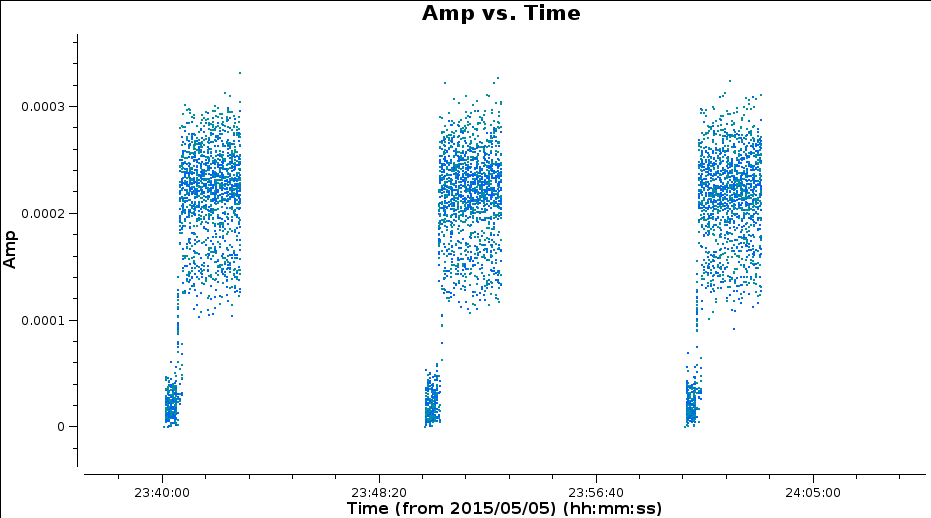
Roughly the same interval at the start of each scan is bad for all sources and antennas, so the phase reference is a good source to examine. (In a few cases there is extra bad data, ignor that for now). Use zoom, and Tools hover and display to estimate the time interval and enter it in flagdata as below.
First, back up the existing flagging state
# in CASA flagmanager(***) # Set the input file name, the mode to save the existing flagging state, and a name to save in.
Use flagdata mode quack to flag the first few tens of seconds (as you identified from plotms) of each scan.
# in CASA
flagdata(vis='***',
mode='***',
quackinterval=***)
Re-plot in plotms (tick reload option and replot if you
still have it open) to check that the bad data at the start of each scan
are gone. There are still some irregular periods of bad data which
will be flagged later. 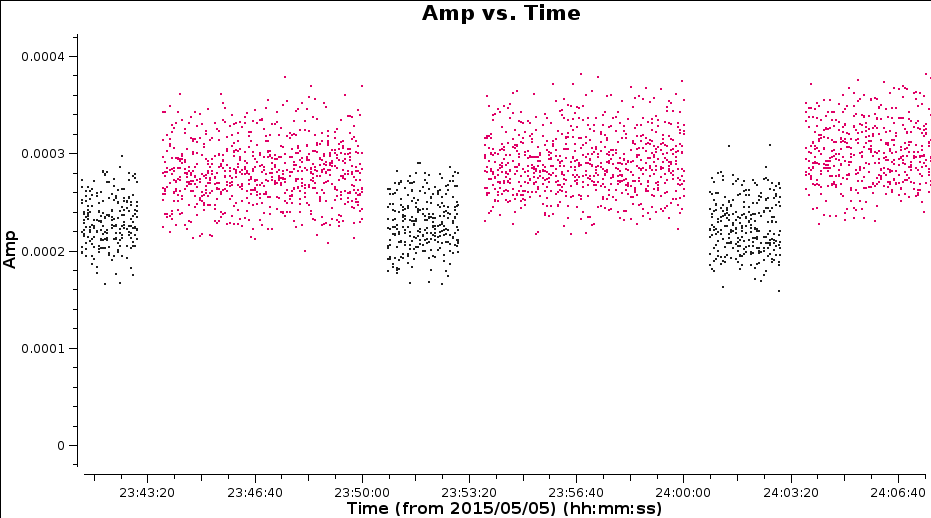
The edges of the bandpass for each spw are low sensitivity and must be flagged. This is the same for all sources, polarizations and antennas but different spectral windows may be different. Just look at the brightest source, 0319+415.
# in CASA
plotms(vis='***',
field='***',
xaxis='***',yaxis='***', # plot amplitude against channel
antenna='***', # select one baseline
correlation='**,**', # just parallel hands
avgtime='***', # set to a large number
avgscan=*, # average all scans
iteraxis='***', # view each spectral window in turn
coloraxis='***') # as you please
Note the channel ranges which are significantly less sensitive at each end of each spw.
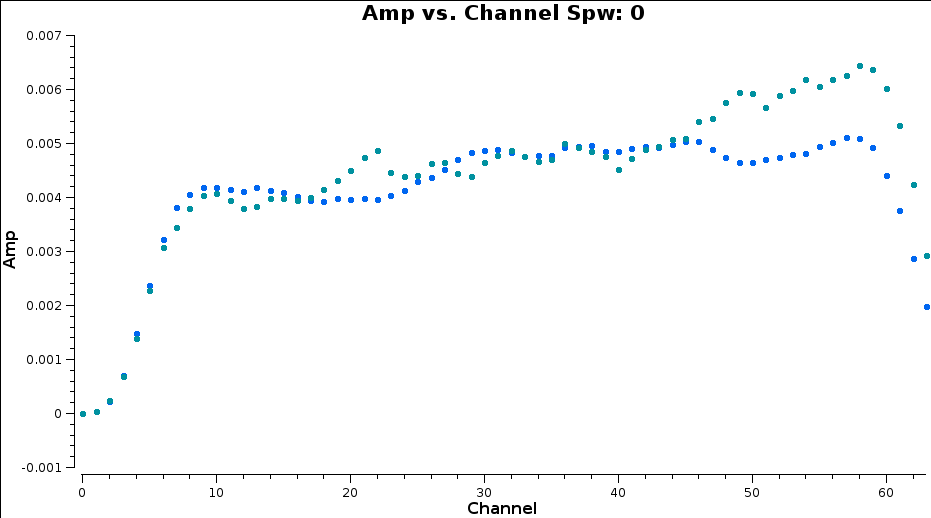
Back up the flags and enter the appropriate parameters in flagdata
# in CASA
flagmanager(***)
flagdata(vis='***',
mode='manual',
spw='0:0~6;60~63,***') # enter the ranges to be flagged for the other spw
Re-plot in plotms
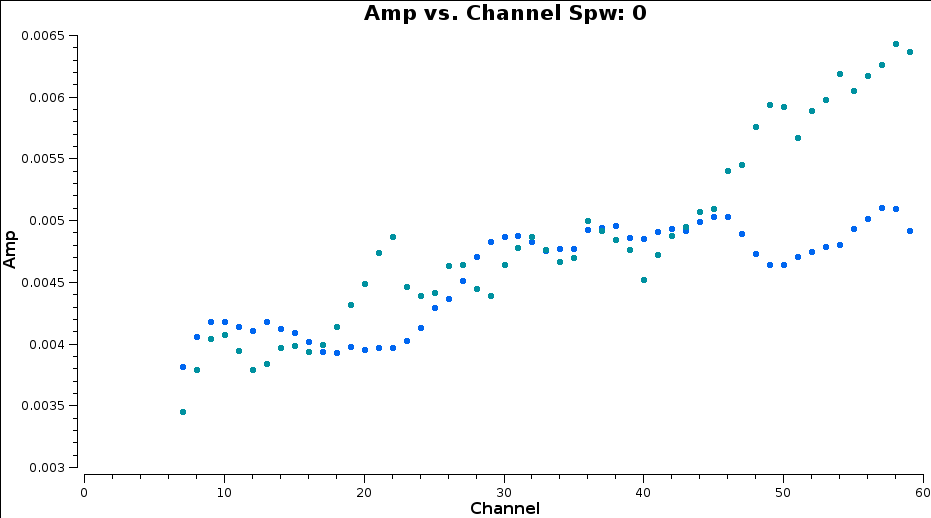
Finally, you usually have to go through all baselines, averaging channels and plotting amplitude against time. To save time (and sanity!), you don't have to do it all here. Have a look at 0319+419 and write down a few commands. This is done in the form of a list file, which has no commas and the only spaces must be a single space between each parameter for a given flagging command line. Some errors affect all the baselines to a given antenna; others (e.g. correlator problems) may only affect one baseline. Usually all spw will be affected so you can just inspect one but check afterwards that all are 'clean'. It can be hard to see what is good or bad for a faint target but if the phase-ref is bad for longer than a single scan then usually the target will be bad for the intervening time. Because the data are taken over two days,it is safest to use the full date for any timerange.
Back up the flags with flagmanager
Use plotms to inspect 0319+415, plotting amplitude against time, RR,LL only, averaging all channels, all baselines to Mk2, paging (iterating) through the baselines.
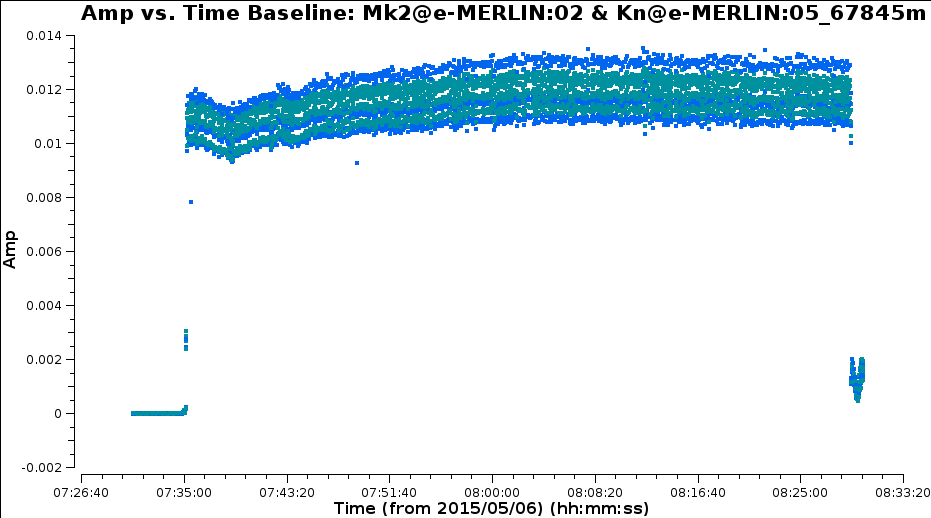
Here are the flagging commands in list format for the data shown below
mode='manual' field='0319+415' timerange='2015/05/06/07:30:00~07:35:00' mode='manual' field='0319+415' antenna='Da' timerange='2015/05/06/07:30:00~07:56:22' mode='manual' field='0319+415' antenna='Mk2&Kn' timerange='2015/05/06/07:30:00~07:35:34' mode='manual' field='0319+415' antenna='Mk2&Kn' timerange='2015/05/06/07:48:55~07:48:58' mode='manual' field='0319+415' antenna='Mk2,De' timerange='2015/05/06/07:35:00~07:35:18' mode='manual' field='0319+415' timerange='2015/05/06/08:28:30~08:30:00'
Note that, by paging through all the baselines, you can figure out what bad data affect which antennas.
Have a look at 1331+305 and write its commands.
The commands are applied in flagdata using mode='list', inpfile='***' where inpfile is the name of the flagging file. Write a file all_avg_1.flags with all the commands to flag bad data. Apply it in flagdata using mode 'list'. Look carefully at the messages in the logger and terminal in case any syntax errors are reported.
Re-plot the data to check that it is now clean!
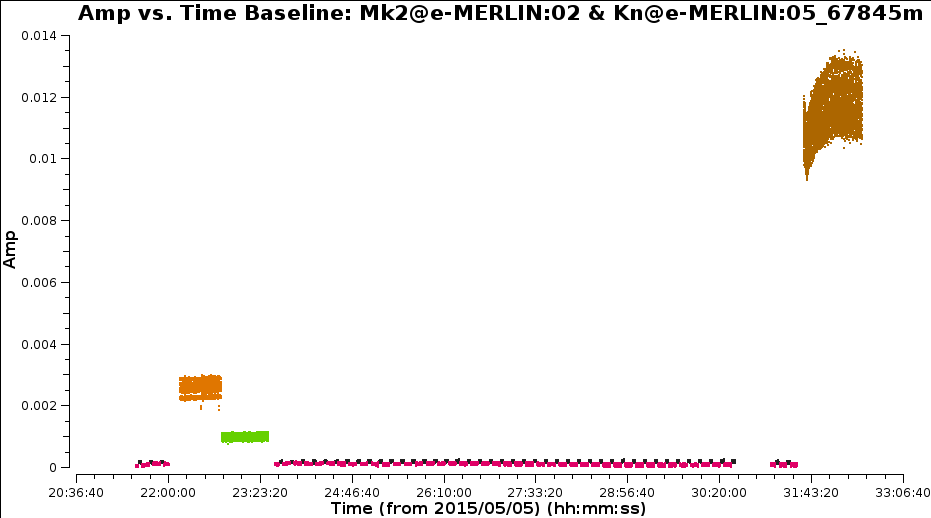
Plot the raw phase against frequency for a bright source. This is usually a bandpass calibrator.
#In CASA: default plotms vis='all_avg.ms' field='0319+415' xaxis='frequency' gridrows=5;gridcols=1;iteraxis='baseline' # Plot multiple baselines on one page yaxis='phase' antenna='Mk2&*' # Plot all baselines to the reference antenna avgtime='600' # Average 10 min correlation='LL,RR' coloraxis='corr' # Type plotms to start the plotter # You can change parameters interactively in plotms
The y-axis spans -200 to +200 deg and some data has a slope of about a full 360 deg across the 512-MHz bandwidth.
QUESTION 1 What is the apparent delay error this corresponds to? What will be the effect on the amplitudes? Answer 1
QUESTION 2 Delay corrections are calculated relative to a reference antenna which has its phase assumed to be zero, so the corrections factorised per other antenna include any correction due to the refant. Roughly what do you expect the magnitude of the Cm corrections to be? Do you expect the two hands of polarization to have the same sign? Answer 2
Plot amplitude against time for just one channel per spw.
# In CASA: default plotms vis='all_avg.ms';field='0319+415' avgtime='60';antenna='Mk2&Cm';correlation='RR' # 60-sec average, one baseline/pol xaxis='time';yaxis='amp';ydatacolumn='data' # Plot amplitude v. time with fixed y scale plotrange=[-1,-1,0.01,0.018];coloraxis='spw' spw='0~3:55' # Just one channel per spw plotms
# In CASA: default plotms vis='all_avg.ms';field='0319+415' avgtime='60';antenna='Mk2&Cm';correlation='RR' # 60-sec average, one baseline/pol xaxis='time';yaxis='amp';ydatacolumn='data' # Plot amplitude v. time with fixed y scale plotrange=[-1,-1,0.01,0.018];coloraxis='spw' spw='0~3';avgchannel='64' # Average all unflagged channels plotms
Plots of amplitudes for 3C84, Mk2-Cm, pol RR for a single channel (left) and all channels (right).
QUESTION 3 In the plots, which has the higher amplitudes - the channel-averaged data or the single channel? Why? Answer 3
The CASA task gaincal is used to derive most calibration. Type inp gaincal or help gaincal to find out more. Fill in the **.
# In CASA:
os.system('rm -rf all_avg.K') # Remove any old version
default gaincal
vis='all_avg.ms'
gaintype='**' # Delay calibration (see help gaincal)
field= '1302+5748,0319+415,1407+284,1331+305' # All calibration sources
caltable='all_avg.K' # Output table containing corrections
spw='0~3'
solint='**' # 600s solution interval
refant='**' # Reference antenna (phase set to origin)
minblperant=2 # For each antenna and solint, require solutions on
minsnr=2 # at least 2 baselines with S/N > 2
inp gaincal # check inputs
** # Type the task name to run
Inspect the solutions. Are they of the magnitude you expect?
# In CASA: default plotcal caltable='all_avg.K' xaxis='**';yaxis='**' # Plot delay against time subplot=321; iteration='antenna' # Each antenna in a separate pane, coloured by spw figfile='all_avg.K.png'
The solutions are stable in time, showing that the phase ref solutions can be applied to the target.
1331+305 (= 3C286) is an almost non-variable radio galaxy and its total flux density is very well known as a function of time and frequency (Perley & Butler 2013) . It is somewhat resolved by e-MERLIN, so we use a model made from a ~12-hr observation centred on 5.5 GHz. This is scaled to the current observing frequency range (around 5 GHz) using {{setjy}} which derives the appropriate total flux density, spectral index and curvature using parameters from Perley & Butler (2013). However, a few percent of the flux is resolved-out by e-MERLIN; the simplest way (at present) to account for this is later to scale the fluxes derived for the other calibration sources by 0.938 (based on calculations for e-MERLIN by Fenech et al.).
The model is a set of clean components (see Imaging tutorial) and setjy enters these in the Measurement Set so that their Fourier transform can be used as a uv-plane model to compare later with the actual visibility amplitudes. If you make a mistake (e.g. set a model for the wrong source) use task delmod> to remove it.
# In CASA: default setjy vis='**' field='**' standard='Perley-Butler 2013' model='3C286_C.clean.model.tt0' # You should have downloaded and untar'd this model **
By default, setjy scales the model for each channel, as seen if you plot the model amplitudes against uv distance, coloured by spectral window. If you have plotms running, go to the axes and select the model, or see the script for inputs. The model only appears for the baselines present for the short time interval for which 1331+305 was observed here.
Fourier plane model of 1331+305, amp v. uv distanceWe have a Catch 22 situation: in order to derive good time-dependent corrections we need to average amplitude as well as phase in frequency, but in order to average in frequency we need the phase to be flat in time and the amplitude to have the correct spectral index. So we derive initial time-dependent solutions for the bandpass calibration sources, but discard these after they have been applied to derive the initial bandpass solutions. These, in turn, are replaced in script step 11.
Estimate the time-averaging interval for phase by plotting phase against time for a single channel near the centre of the band for a bandpass calibration source. If the results for the first channel you try look bad, it may be a partly flagged channel; try a different one.
# In CASA: default plotms vis='all_avg.ms' field='**' # Plot bandpass calibrator spw='0~3:55' # This gives all spw, channel 55 in each. antenna='**' # Plot the longest baseline to the refant, likely to have the fastest-changing phase xaxis='time'; yaxis='phase';ydatacolumn='data' # Plot raw phase against time, no averaging coloraxis='spw' **
Zoom to help decide what phase solution interval to use. The integration-to-integration scatter is noise (mostly instrumental) which cannot be removed but the longer-term wiggles are mainly due to the atmosphere and we want to derive corrections to reduce these to about the level of the noise or at least to less than 5-10 deg. The longer a solution interval, the better the S/N but the interval has to be short enough not to average over the wiggles.
Zoom in on plot of 0319+415 uncorrected phase v. time (correlation 'RR')QUESTION 4 The plot shows 4 spw. What other effect, apart from atmospheric phase errors, will be solved by calibrating phase against a point model at the phase centre? Answer 4
# In CASA:
os.system('rm -rf bpcals_precal.p1')
default gaincal
vis='all_avg.ms'
caltable='bpcals_precal.p1' # The output solution table
calmode='**' # Solve for phase only as function of time
field='**, **' # Two sources suitable for bandpass calibration were observed
solint='**' # Enter a suitable solution interval
refant='**'
minblperant=2; minsnr=2
gaintable='all_avg.K' # Apply the delay solutions to allow averaging phase across the band
**
Check the solutions. Each spw should have a coherent set of solutions, not just noise.
# In CASA: default plotcal caltable='bpcals_precal.p1' xaxis='**'; yaxis='**' subplot=321; plotrange=[-1,-1,-180,180]; iteration='antenna' plotcal
The plot of amplitude against time in Step 6 also showed that the uncorrected amplitudes have only a slow systematic slope with time, so a longer solution interval can be used, minimising phase noise.
QUESTION 5 Why solve for phase separately before solving for amplitude? Answer 5
Now derive amplitude solutions. We have not yet derived flux densities for the bandpass calibration sources so we have to normalise the gains (i.e. individual solutions differ but the product is unity so that the overall flux scale is not affected). Thus we have to derive the solutions separately for each of the two bandpass calibrators but write them to the same solution table.
# In CASA
os.system('rm -rf bpcals_precal.ap1')
default gaincal
vis='all_avg.ms'
calmode='**' # Solve for amplitude and phase v. time
field='0319+415'
caltable='bpcals_precal.ap1' # Output solution table
solint='**' # Longer solution interval
solnorm=** # Normalise the amplitude solutions,
refant='Mk2'
minblperant=2;minsnr=2
gaintable=['all_avg.K','bpcals_precal.p1'] # Apply the existing delay and phase solutions
**
field='1407+284' append=T # Add solutions to existing table **
# In CASA default plotcal **
Use bandpass to derive solutions for phase and amplitude as a function of frequency (i.e., per channel). In order to allow averaging in time, apply the time-dependent corrections which you have just derived.
# In CASA:
os.system('rm -rf bpcal.B1')
default bandpass
vis='all_avg.ms'
caltable='bpcal.B1' # New table with bandpass solutions
field='**,**' # Bandpass calibration sources
fillgaps=16 # Interpolate over flagged channels
solint='inf';combine='scan' # Average the whole time for each source
refant='**'
solnorm=** # Normalise solutions
gaintable=['all_avg.K','bpcals_precal.p1','bpcals_precal.ap1'] # Apply all the tables derived for these sources
minblperant=2; minsnr=3
**
You may see messages about failed solutions but these should all be for the end channels which were flagged anyway.
Inspect the solutions in plotcal. The phase corrections are small as the delay solutions were already applied. The amplitude solutions will remove local deviations from the bandpass but the corrections so far assume that the source flux density is flat in each spw.
# In CASA default plotcal caltable='bpcal.B1' xaxis='freq';yaxis='phase';plotrange=[-1,-1,-180,180] # Plot phase solutions v. frequency iteration='antenna';subplot=321 plotcal yaxis='amp';plotrange=[-1,-1,-1,-1] # Plot amp solutions, self-scaled plotcal
Apply the delay and bandpass solutions to the calibration sources as a test, to check that they have the desired effect of producing a flat bandpass for the phase-reference. There is no need to apply the time-dependent calibration as we have not derived this for the phase-reference source anyway. Some notes about applycal:
help applycal).The delay correction ('K') table contains entries for all sources except the target. The phase reference scans bracket the target scans so it is OK to use the default 'linear' interpolation.
The bandpass ('B1') table is derived from just two bandpass calibration observation and there may be data for other sources outside these times, so extrapolation in time is needed, using 'nearest'. 'linear' interpolation is OK for the bandpass calibrator in frequency.
If you are finding your laptop is slow, you can skip this applycal and the plotms immediately after and just look at the figures here and go to Step 9.
# In CASA: default applycal vis='all_avg.ms' field='0319+415,1302+5748,1331+305,1407+284' calwt=F; applymode='calonly' # Test, so don't change the weights or flag data with failed solutions gaintable=['**','**'] # Enter the names of the tables used to calibrate the bandpass interp=['**,**','**,**']) # The values depend on which table you listed first. **
Check that the bandpass corrections are good for all data by plotting the 'before and after' phase reference phase and amplitude against frequency.
# In CASA: default plotms vis='all_avg.ms'; field='1302+5748' # Phase reference xaxis='frequency';yaxis='phase';ydatacolumn='data' # First, plot uncorrected phase gridrows=5;gridcols=1;avgtime='600';coloraxis='scan' iteraxis='baseline';antenna='Mk2&*';correlation='LL,RR' plotms ydatacolumn='corrected' # Repeat for corrected phase plotms yaxis='amp';ydatacolumn='data' # Uncorrected amplitude plotms ydatacolumn='corrected' # Repeat for corrected amp plotms
In the Figure, each scan is coloured separately and shows a random offset in phase and some discrepancies in amplitude compared to other scans, but for each individual time interval it is quite flat. So we can average in frequency across each spw and plot the data to show remaining, time-dependent errors.
Plot the corrected phase against time with all channels averaged for the phase reference source. Zoom in on a few scans to deduce a suitable averaging timescale for correction of phase errors as a function of time, i.e. where atmospheric fluctuations dominate over noise.
# In CASA: default plotms vis='all_avg.ms'; field='1302+5748' xaxis='time';yaxis='phase';ydatacolumn='corrected' antenna='Mk2&*';iteraxis='baseline' avgchannel='64'; coloraxis='spw' correlation='LL' # Just one pol as previous plots show both are similar plotms
Repeat for amplitude.
Two scans on the phase ref showing bandpass-corrected amp, coloured by spwDerive time-dependent solutions for all the calibration sources, applying the delay and bandpass tables.
# In CASA:
os.system('rm -rf calsources.p1')
default gaincal
vis='all_avg.ms'
calmode='p' # Phase only first
caltable='calsources.p1'
field='**' # All calibration sources
solint='**' # Insert solution interval
refant='Mk2'
minblperant=2;minsnr=2
gaintable=['all_avg.K','bpcal.B1'] # Existing correction tables to apply
interp=['**,**','**,**'] # Insert suitable interpolation modes
gaincal
When you run gaincal, check the messages in the logger and the terminal.
The logger shows something like:
2015-05-21 06:28:39 INFO gaincal Calibration solve statistics per spw:
(expected/attempted/succeeded):
2015-05-21 06:28:39 INFO gaincal Spw 0: 1400/935/930
2015-05-21 06:28:39 INFO gaincal Spw 1: 1400/935/930
2015-05-21 06:28:39 INFO gaincal Spw 2: 1400/935/930
2015-05-21 06:28:39 INFO gaincal Spw 3: 1400/935/930
Insufficient unflagged antennas to proceed with this solve. (time=2015/05/06/06:32:26.5 field=0 spw=0 chan=0)
Plot the solutions, separately for L and R for clarity:
# In CASA: default plotcal caltable='calsources.p1' xaxis='time';yaxis='phase' plotrange=[-1,-1,-180,180] poln='L' # Note that solutions are per antenna, hence 'L' not 'LL' iteration='antenna';subplot=321 plotcal poln='R' plotcal
Derive time-dependent solutions for all the calibration sources, applying the delay and bandpass tables and the time-dependent phase solution table.
At this point, 1331+305 has a realistic model set in the MS (Step 7). The other calibration sources have the default of a 1 Jy point source at the phase centre. If (and only if) you are repeating a failed attempt, reset any previous models for sources other than 1331+305.
# In CASA: default delmod vis='all_avg.ms' field='0319+415,1407+284,1302+5748,1252+5634' delmod
Insert a suitable solution interval (from inspection of the previous amp plots and listobs output), the tables to apply and interpolation modes. Note that if you set a solint longer than a single scan on a source, the data will still only be averaged within each scan unless an additional 'combine' parameter is set, not needed here.
# In CASA:
os.system('rm -rf calsources.ap1')
default gaincal
vis='all_avg.ms'
calmode='ap' # Amplitude and phase
caltable='calsources.ap1'
field='1302+5748,0319+415,1407+284,1331+305' # All calibration sources
solint='**' # Insert solution interval.
solnorm = F # Solutions will be used to determine the flux scale - don't normalise!
refant='Mk2'
minblperant=2;minsnr=2
gaintable=['all_avg.K','bpcal.B1','calsources.p1']
interp=['**,**','**,**','**,**'] # Insert suitable interpolation modes
gaincal
The logger shows a similar proportion of expected:attempted solution intervals as for phase, but those with failed phase solutions are not attempted so all the attempted solutions work.
Plot the solutions separately for L and R for clarity:
# In CASA: default plotcal caltable='calsources.ap1';xaxis='time';yaxis='amp' plotrange=[-1,-1,-1,-1];poln='L' # Note that solutions are per antenna, hence 'L' not 'LL' iteration='antenna';subplot=321 plotcal poln='R' plotcal
The solutions for 1331+305 in calsources.ap1 contain the correct scaling factor to convert the raw units to Jy as well as removing time-dependent errors. This is used to calculate the scaling factor for the other calibration sources in fluxscale. We run this task in a different way because the calculated fluxes are returned in the form of a python dictionary. They are also written to a text file. Only the best data are used to derive the flux densities but the output is valid for all antennas. This method assumes that all sources without starting models are points, so it cannot be used for an extended target.
# In CASA:
os.system('rm -rf calsources.ap1_flux calsources_flux.txt')
inp fluxscale
calfluxes=fluxscale(vis='all_avg.ms', # calfluxes will hold the calculated fluxes in memory
caltable='calsources.ap1', # Input table containing amplitude solutions
fluxtable='calsources.ap1_flux', # Scaled output table
listfile='calsources_flux.txt', # Text file on disk listing the calculated fluxes
gainthreshold=0.3, # Exclude solutions >30% from mean
antenna='!De', # Exclude least sensitive antenna
reference='1331+305') # Source with known flux density and previous model
If you type calfluxes this will show you the python dictionary, but if you don't yet know how to parse this, look at the logger or the listfile, calsources_flux.txt:
# In CASA !more calsources_flux.txt # Use of ! to invoke shell command
The individual spw estimates may have uncertainties up to ~20% but the bottom lines give the fitted flux density and spectral index for all spw which should be accurate to a few percent. These require an additional scaling of 0.938 to allow for the resolution of 1331+305 by e-MERLIN (see Setting the flux of the primary flux scale calibrator (script step 7)). The python dictionary is used:
# In CASA:
eMcalfluxes={}
for k in calfluxes.keys():
if len(calfluxes[k]) > 4:
a=[]
a.append(calfluxes[k]['fitFluxd']*0.938)
a.append(calfluxes[k]['spidx'][0])
a.append(calfluxes[k]['fitRefFreq'])
eMcalfluxes[calfluxes[k]['fieldName']]=a
print 'eMcalfluxes =', eMcalfluxes
This should show eMcalfluxes as a dictionary; the first column or 'key' is the source name and the values are [flux density (Jy), spectral index and reference frequency (Hz)].
eMcalfluxes = {'0319+415': [22.923054518822898, 1.3880696489251445, 5006954727.795684],
'1302+5748': [0.4038246569666556, -0.36601000555046109, 5006954727.795684],
'1407+284': [1.9029244229026492, 0.30721870168508297, 5006954727.795684]}
You may get slightly different values if you have chosen different solution intervals but if they are more than a few percent different something is probably wrong.
Use setjy in a loop to set each of the calibration source flux densities. The logger will report the values being set.
# In CASA:
for f in eMcalfluxes.keys(): # For each source in eMcalfluxes:
setjy(vis='all_avg.ms',
field=f,
standard='manual', # Use our values, not a built-in catalogue
fluxdensity=eMcalfluxes[f][0],
spix=eMcalfluxes[f][1],
reffreq=str(eMcalfluxes[f][2])+'Hz')
The default in setjy is to scale by the spectral index for each channel and plotting the models for the bandpass calibrators shows a slope corresponding to the spectral index (zoom in on the fainter source to see this). Both sources have positive spectral indices in this frequency range; this is less unusual for compact, bright QSO than for radio galaxies in general. Plot the models for the bandpass calibrators, amplitude against frequency, to see the spectral slopes.
# In CASA: default plotms vis='all_avg.ms'; field='0319+415,1407+284' # Plot the bandpass calibrators xaxis='**' yaxis='**';ydatacolumn='**' # Fill in axis and data types coloraxis='spw';correlation='LL' # Just LL for speed; model is unpolarized customsymbol=T;symbolshape='circle'; symbolsize=5 # Bigger symbols plotms
Use the models including spectral indices to derive a more accurate bandpass correction. You can use the first use of bandpass as a guide but there are three major differences (apart from writing a different table).
# In CASA:
os.system('rm -rf bpcal.B2')
default bandpass
vis='all_avg.ms'
caltable='bpcal.B2'
field='**,**'
fillgaps='**'
solint='**'
combine='**'
solnorm='**' # There are now accurate flux densities and spectral indices
gaintable=['all_avg.K','**','**'] # and updated time-dependent solutions
refant='Mk2'
gainfield='**,**' # but the new solutions contain entries for a number of sources
minblperant=2;minblperant=2;minsnr=3
**
Plot the bandpass solutions:
# In CASA: default plotcal caltable='bpcal.B2';xaxis='freq', plotrange=[-1,-1,-180,180] iteration='antenna';yaxis='phase';subplot=321 ** # Repeat to plot amplitude
The same wiggles as in B1 (see "Amplitude bandpass solutions B1, coloured by spw") are corrected, but there is a different overall slope (e.g. compare Kn solutions.)
For each calibration source, there is now a flux density and spectral index set for the MS Model column, as well as the delay, phase and improved bandpass calibration. These are used to derive time-dependent amplitude solutions which will both correct for short-term errors and contain an accurate flux scale factor.
Look at the previous time that you ran gaincal, and identify the one thing which you need to change now (apart from the output table name).
# In CASA:
os.system('rm -rf calsources.ap2')
default gaincal
vis='all_avg.ms'
caltable='calsources.ap2'
**
Plot the solutions
# In CASA: default plotcal caltable='calsources.ap2' xaxis='time';yaxis='amp' subplot=321;iteration='antenna';poln='L' plotrange=[-1,-1,0.01,0.06] plotcal # Repeat for the other polarization
You expect to see a similar scaling factor for all sources. 1331+305 is somewhat resolved, giving slightly higher values for Cm (the antenna giving the longest baselines).
Finally, we need phase solutions that can be applied to the target source. Because we will interpolate solutions between phase calibrator scans, we just need one phase solution pero phasecal scan. So solint should include all the data from each scan to form a solution.
# In CASA:
os.system('rm -rf calsources.p2')
default gaincal
vis='all_avg.ms'
caltable='calsources.p2'
**
Plot the solutions
# In CASA: default plotcal caltable='calsources.p2' xaxis='time';yaxis='amp' subplot=321;iteration='antenna';poln='L' plotrange=[-1,-1,0.01,0.06] plotcal # Repeat for the other polarization
Apply the bandpass correction to all sources. For the other gaintables, for each calibrator (field), the solutions for the same source (gainfield) are applied. Gainfield '' for the bandpass table means apply solutions from all fields in that gaintable. applymode='calflag' will flag data with failed solutions which is OK as we know that these were due to bad data. We use the non-interactive format to allow us to use a loop over all calibration sources.
Cut and paste this all together; press return a few times afterwards till it runs.
# In CASA:
cals = ['0319+415', '1302+5748', '1331+305', '1407+284']
for c in cals:
applycal(vis='all_avg.ms',
field=c,
gainfield=[c, '',c,c],
calwt=F,
applymode='calflag',
gaintable=['all_avg.K','bpcal.B2','calsources.p1','calsources.ap2'],
interp=['linear','nearest,linear','linear','linear'],
flagbackup=F) # Don't back up flags multiple times here
Apply the phase-ref solutions to the target. We assume that the phase reference scans bracket the target scans so linear interpolation is used except for bandpass. Enter the parameters in interactive mode.
# In CASA: default applycal vis='all_avg.ms' field='1252+5634' # This is the target gainfield=['**','','**','**'] # Enter the field whose solutions are applied to the target calwt=**; applymode='**' gaintable=['**','**','**','**'] interp=['**','**,**','**','**'] flagbackup=True **
# In CASA: default plotms vis='all_avg.ms' field='1302+5748' # phase-ref xaxis='uvdist'; yaxis='amp'; ydatacolumn='corrected' avgchannel='64';correlation='LL,RR';coloraxis='spw' ** # Note what it looks like and/or make a plotfile and then plot the target.
QUESTION 6 What do the plots of amplitude against uv distance tell you? Answer 6
Split out corrected target data. By default, this will take the corrected column.
# In CASA: default split vis='all_avg.ms' field='1252+5634' outputvis='1252+5634.ms' keepflags=F split
In CASA 4.4 and earlier, you need to correct a minor incompatibility between the e-MERLIN data structure and the expected measurement set format; it does not affect anything except listobs.
# In CASA:
tb.open('1252+5634.ms',nomodify=F)
SIDorig=tb.getcol('STATE_ID')
SID=SIDorig*0
SIDnew=SID-1
tb.putcol('STATE_ID',SIDnew)
tb.close()
WARNING: do not try to run listobs on a Mac, it will not work due to a bug in CASA 4.4 (maybe 4.5)
Instead, click here to see the output you would have got: 1252+5634.listobs.txt
# In CASA: default listobs vis='1252+5634.ms' overwrite=True listfile='1252+5634.listobs.txt' **
Script with all commands to follow the tutorial: 3C277.1_cal_all.py